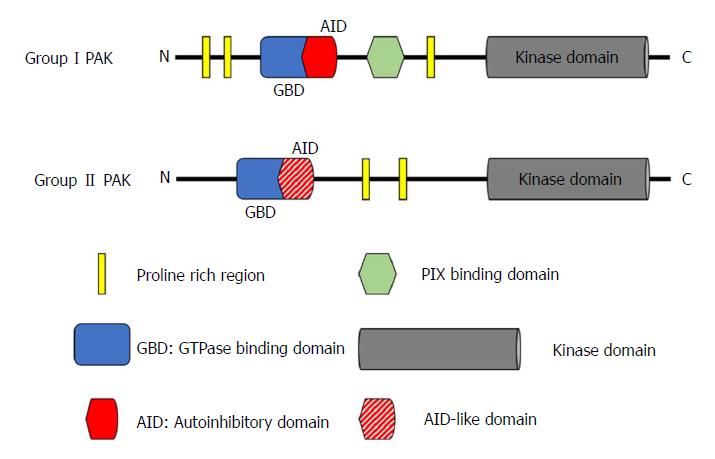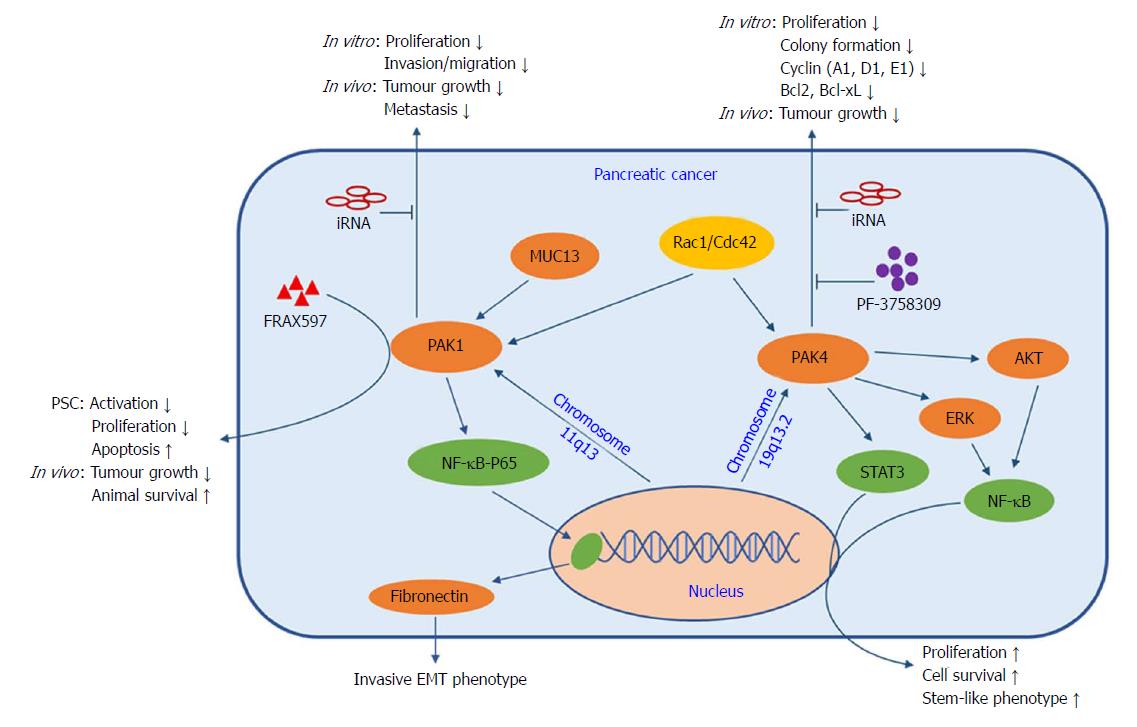Copyright
©The Author(s) 2018.
World J Gastroenterol. Sep 7, 2018; 24(33): 3709-3723
Published online Sep 7, 2018. doi: 10.3748/wjg.v24.i33.3709
Published online Sep 7, 2018. doi: 10.3748/wjg.v24.i33.3709
Figure 1 Structure of p21-activated kinases.
The six members of the PAK family can be divided by sequence and structural differences into two groups: Group I (PAK1-3) and group II (PAK4-6). All PAKs have an N-terminal regulatory domain and a conserved C-terminal serine/threonine kinase domain. In group I PAKs, the regulatory domain contains an AID, whereas group II PAKs (with the possible exception of PAK5) do not have a well-defined AID, but instead an AID-like domain. PIX: PAK-interactive exchange factor; PAK: p21-activated kinases; AID: Autoinhibitory domain; GBD: GTPase-binding domain.
Figure 2 Role of p21-activated kinases in Kras-driven oncogenic signalling pathways.
Rac1 is the 4th best validated effector in Kras signalling and is a well-defined upstream protein of PAKs. Rac1 plays an important role in the ADM/PanIN/PDAC transition. In addition, Rac1/Cdc42 mediates this pathological process via the PI3K-PDK1 signalling pathway. PDK1 can also interact with PAK1, leading to its phosphorylation. The Kras oncogene activates PAKs through direct and indirect pathways. Activated PAKs can increase cancer cell proliferation, migration and survival through activation of AKT, Crk and RAF-MEK-ERK pathways. PAK: p21-activated kinases; ADM: Acinar-ductal metaplasia; PDAC: Pancreatic ductal adenocarcinoma; PDK1: Phosphoinositide-dependent kinase-1.
Figure 3 p21-activated kinases signalling in the development of pancreatic cancer.
PAK signalling is involved in several pathobiological processes in pancreatic cancer, including proliferation, migration/invasion, apoptosis and maintenance of stem cell-like properties. Amplification of the PAK1 and PAK4 genes, present within the chromosomal regions 11q13 and 19q13.2, respectively, has been observed. Activated PAK1 regulates cell transformation and the invasive EMT phenotype of pancreatic cancer cells via the NF-κB-p65-fibronectin axis. Additionally, MUC13 promotes cancer cell growth and invasion/migration, and reduces animal survival, by up-regulating expression and phosphorylation of PAK1. Furthermore, PAK4 modulates proliferation and survival by mediating the activity of NF-κB via AKT- and ERK-dependent pathways, and cancer stem cell-like properties via STAT3 signalling. Pharmacological or genetic inhibition of PAK1 or PAK4 leads to decreased cancer cell proliferation, invasion/migration and PSC activation in vitro, and reduced tumour growth and metastasis, and increased animal survival in vivo. PAK: p21-activated kinases; PSC: Pancreatic stellate cells.
- Citation: Wang K, Baldwin GS, Nikfarjam M, He H. p21-activated kinase signalling in pancreatic cancer: New insights into tumour biology and immune modulation. World J Gastroenterol 2018; 24(33): 3709-3723
- URL: https://www.wjgnet.com/1007-9327/full/v24/i33/3709.htm
- DOI: https://dx.doi.org/10.3748/wjg.v24.i33.3709











